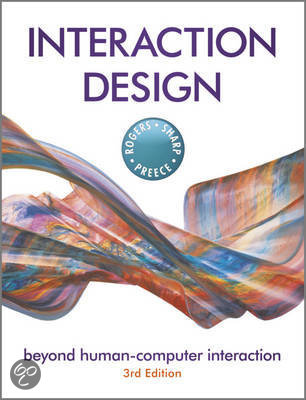Human-Centered Design
Week 2 – 8, Literature Summary
,Week 2 - The process of Interaction Design (p. 37 – 54)
2.1 Introduction
There are various disciplines in the design world, such as: graphic design, architectural design, industrial
design, and software design. Each having their own structure of getting to a product.
The double diamond of design captures the similarities of these design disciplines. This approach has 4
phases:
1. Discover: Designers try to gather insights about the problem.
2. Define: Designers develop a clear brief that frames the design challenge + problem statement.
3. Develop: Solutions or concepts are created, prototyped, tested, and iterated.
4. Deliver: The resulting project is finalized, produced, and launched
Traditionally, user-centered designers begin by doing user research and then sketching their ideas.
2.2 What Is Involved in Interaction Design?
Users are involved appropriately in the development process itself. This means that users’ concerns direct
the development process. Design is also about trade-offs; how much choice will be given to the user and
how much direction the system should offer? This depends on the purpose of the system.
Getting the balance right requires experience, but it also requires the development and evaluation of
alternative solutions. Generating alternatives is a key principle in most design disciplines and one that is
also central to interaction design.
“The best way to get a good idea is to get lots of ideas.” ~ Linus Pauling (Nobel Prize winner)
Generating lots of ideas is not necessarily hard, but choosing which of them to pursue is more difficult.
Involving users and others in the design process means that the designs and potential solutions will need to
be communicated to people other than the original designer. There are several ways to do so, a
combination of these techniques is likely to be the most effective:
Produce a series of sketches
Write a description in natural language
Draw a series of diagrams
Build a prototype (a limited version of the final product)
, 2.2.1 Understanding the Problem Space
This is the first phase of the double diamond, the discover phase. In this phase, the users are understood
and you get familiarized with their usability and user experience preferences. This is called, understanding
the problem space. The main questions to answer here are:
1. What is currently the user experience or the product?
2. Why a change is needed?
3. And how will this change improve the user experience?
The process of articulating the problem space is typically done as a team effort. Invariably, team members
will have differing perspectives. For example, a project manager is likely to be concerned about a proposed
solution in terms of budgets, timelines, and staffing costs, whereas a software engineer will be thinking
about breaking it down into specific technical concepts.
2.2.2 The importance of involving users
In commercial projects, a role called the product owner is common. The product owner’s job is to filter user
and customer input to the development cycle and to prioritize requirements or features. This person is
usually someone with business and technical knowledge, but not interaction design knowledge, and they
are rarely a direct user of the product. Therefore, they are called: a proxy-user. And their involvement does
not avoid the need for user involvement.
Two other aspects unrelated to functionality are equally as important if the product is to be usable and
used:
1. Expectation management is the process of making sure that the users’ expectations of the new
product are realistic. Its purpose is to ensure that there are no surprises for users when the product
arrives.
a. Marketing of the new arrival must be careful not to misrepresent the product, although it
may be particularly difficult to achieve with a large and complex system. How many times
have you seen an advertisement for something that you thought would be really good to
have, but when you actually see one, you discover that the marketing hype was a little
exaggerated? Then you felt quite disappointed and let down. This is what expectation
management tries to avoid.
b. Involving users throughout development helps with expectation management because they
can see the product’s capabilities from an early stage.
2. Ownership
a. Users who are involved and feel that they have contributed to a product’s development are
more likely to feel a sense of ownership toward it and support its use
2.2.3 Degrees of User involvement
Where available, individual users may be co-opted onto the design team so that they are major contributors
to the development. This has pros and cons.
Con
On the downside, full-time involvement may mean that they become out of touch with their user
community, while part-time involvement might result in a high workload for them.
Pro
On the positive side, having a user engaged full or part-time does mean that the input is available
continually throughout development
There are other ways of user involvement. Once a product has been released, a different kind of user
involvement is possible—one that captures data and user feedback based on day-to-day use of the product.
Error reporting systems (ERSs, also called online crashing analysis) automatically collect information from
users that is used to improve applications in the longer term.





